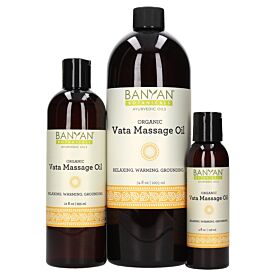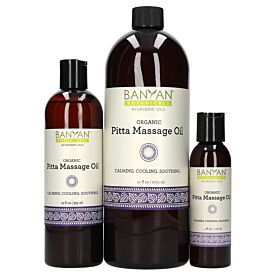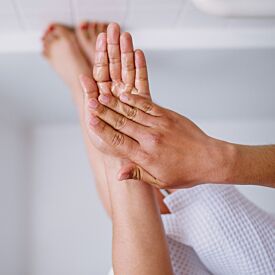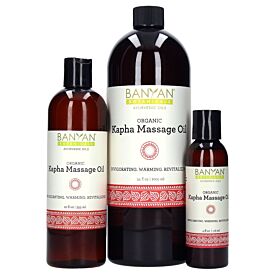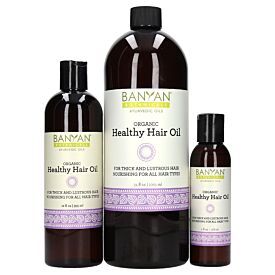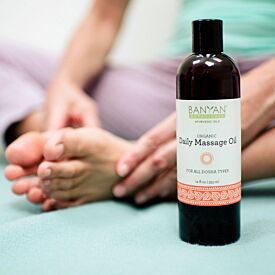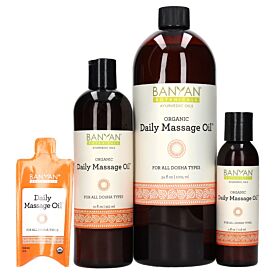Body Oiling and the Skin Microbiome
One of my favorite practices in Ayurveda is abhyanga—the art and science of applying oil to the body. When I began studying Ayurveda in 2007 at The Chopra Center, I remember fondly the class in which our instructor showed us how to apply warm herbal oil using firm up and down strokes on the long bones and circular motions on the joints.
Covering myself in warm oil and allowing it time to seep in seemed like heaven to me. “Sign me up!” I thought.
I always remember what we were taught about allowing the oil to stay on the body for at least 20 minutes to absorb into the skin, then showering afterward—specifically, that there is no need to wash the oil off. Allowing a thin sheen to stay on the skin can protect it from environmental toxins, and soap is really only necessary in the “high traffic” areas.
We also learned about the importance of allowing the oil to penetrate through all seven layers of our tissues, known as the dhatus.
By allowing the oil to deeply permeate, we are nourishing the rasa (plasma), rakta (blood), mamsa (muscle), meda (fat), asthi (bone), majja (nerve endings), and shukra or artava (reproductive fluids).
As the Rishis told us over 5,000 years ago, penetration of oil into the dhatus not only nourishes our skin, but also boosts immune strength, stimulates circulation and blood flow, helps rid the body of toxins by engaging the lymphatic system, and keeps the skin healthy and prepared to fight off invaders.
This ancient ritual of body oiling is used in many ways in Ayurveda, including being the basis of panchakarma, or traditional detoxification treatments. While it can be performed by a practitioner for a full experience of relaxation and receiving, it can just as easily be practiced at home as a daily act of sacred self-care.
The many benefits of abhyanga establish it as an integral practice in a healthy routine, and I have a hunch modern science would agree, especially as more is discovered about the skin microbiome. If the term “microbiome” existed at the time, I think we would have seen it in the Ayurvedic texts, for Ayurvedic practices directly impact and support the health of this microbiome.
What Is the Skin Microbiome?
Many years after my initial love affair with abhyanga, I began to learn about the properties of the skin microbiome. Unlike the gut microbiome, which has been talked about for years, it is only recently that we have begun hearing about the good bacteria that is all over our skin.
It’s not surprising that in Ayurveda we call our skin the anna maya kosha, which literally translates to the layer derived from food. Everything that we eat makes its way to the outer protective layer of our body and becomes our first line of defense. That is why it is so incredibly important to eat well.
Equally important is what we do to our skin. How we wash it, what we put on it, how we expose it to the elements, and how we protect it.
Care and nourishment of the anna maya kosha are reflected in the health of our skin and how well our gut digests our food. I believe the ancient practice of abhyanga is undeniably one of the most effective ways we can tend to our skin and the tissues it protects.
Oiling the skin may actually increase activity of the good bacteria by encouraging it to move deeper into the skin where it can flourish.
Cultivating more microbial activity helps the cells communicate at a deeper level, boosts immunity, creates a barrier from harmful pathogens, and offers a layer of protection from environmental threats.
A Closer Look at the Skin Microbiome
Millions of microorganisms live on our skin, which is the largest organ in the body. That includes bacteria, viruses, and fungi that are similar to what we have in our gut.1 And the job of these microorganisms is the same—to protect us against unwanted invaders and pathogens.
According to research performed by Nature Reviews Microbiology in 2018:
“The skin is colonized by beneficial microorganisms and serves as a physical barrier to prevent the invasion of pathogens. In circumstances where the barrier is broken or when the balance . . . is disturbed, skin disease or even systemic disease can result.”2
Another study by the National Institutes of Health notes how the microbiome lives not just on the surface layer of skin (epidermis), but also deep within the dermis—our thick inner layer of skin. The results of the study stated there is “physical contact between bacteria and various cells below the basement membrane.”3
Additionally, the study shows evidence of a “previously unknown physical interaction that routinely occurs between commensal bacteria and dermal cells. This interaction was particularly surprising in the deep dermal…areas that were traditionally assumed to be devoid of a microbial community in the absence of skin injury.”4
The study goes on to speak about how the skin’s microbial community affects the development of the immune system and the physical characteristics of the epidermal barrier, and vice versa.5 I think these studies are proving my point!
The Ayurvedic Approach to Skin Care
Now that it has been proven that skin bacteria live and thrive in the deep layers of our dhatus, we have all the more reason to heed the wisdom of Ayurveda and take the time to care for the health and well-being of our skin.
Here are two simple Ayurvedic tips to keep in mind to best nourish and protect the microbiome.
Oil Your Skin
This recommendation should come as no surprise! To set yourself up for success, keep your favorite body oil on hand to use for your daily abhyanga. You can use an herbal massage oil specific to your dosha or keep it simple with organic sesame oil.
Warm the oil first. After massaging the oil thoroughly into your skin, let it sit for 20 minutes, rinse off in the shower, and continue your day knowing that you have just done your best to protect yourself from whatever the world throws your way.
Avoid Overusing Products
In order to protect the health of the microbiome, it’s best to avoid using harsh cleaners or scrubs on our skin. The microbiome is there to protect and strengthen our entire system. The more we remove this layer through the use of harsh cleaning methods, the more our body needs to work to reproduce a new, healthy community of bacteria.
In his book Clean: The New Science of Skin, author and doctor James Hamblin reveals how to nourish and care for this important organ. He speaks of the trillions of microbes that live in our skin and pores and how they influence everything from our skin condition to the way we smell.6
Over-washing, hand sanitizer use, and even using so-called gentle cleansers can lead to increased skin problems by washing away the diverse, protective bacteria on our skin. All kinds of skin issues, imbalances, and blemishes may be accelerated by removing these healthy and helpful microbes.
Hamblin promotes cultivating a healthy microbiome as the new goal of skincare, coaching us to shower less, use less product on our skin, and rethink what it means to be “clean.”7
Keep It Simple
The final takeaway is to allow your body to do its job. Our system is brilliantly designed to move towards greater health when it is fed and cared for properly.
While Ayurveda provides a plethora of tools and practices to help us maintain balance, it also reminds us over and over to return to a place of simplicity. Often, adding just one meaningful practice to your daily routine can create a profound impact.
So if you love the idea of massaging your skin with oil as much as I do, go ahead and give it a try. Commit to the practice of abhyanga as a way to care for your skin, your microbiome, your deep inner tissue layers, and your overall glowing and radiant health!





